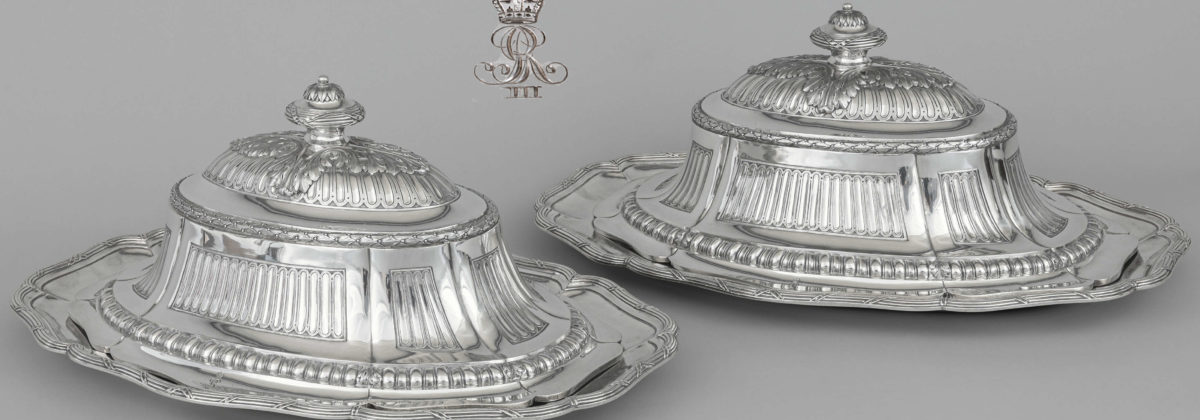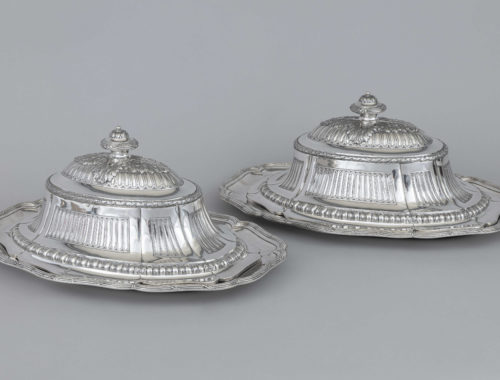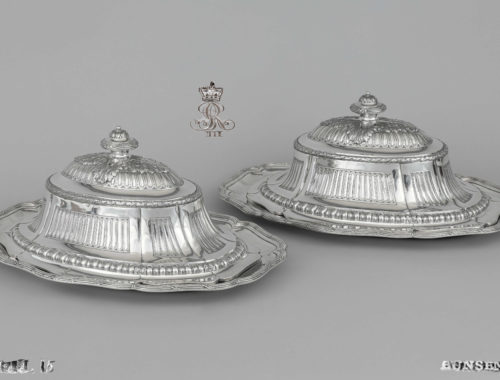Object number :
Dish Covers Hanover ca 1794
Dishes: Hanover ca 1820
Master:
Dish Covers: Frantz Peter Bunsen, see Scheffler Hannover No. 47
Born in 1725, sworn in 1754, court goldsmith from 1770, died in 1795
Dishes: Franz Anton Hans Nübell, see Scheffler Hannover No. 142
Became a citizen of Hanover and court jeweler in 1819 as a goldsmith
oval plates: length 47 cm bells: total weight 7,121 g
Provenance:
King George III of Great Britain and Ireland, Elector and King of Hanover (1760-1820) and then by descent to the Royal House of Hanover;
Sotheby’s tableware, Marienburg Castle, Hanover,
October 2005, lots 1192-1194
literature
- Seelig, “The King George III Silver Service,” The Journal of the Silver Society, 2012, No. 28
Detailed Description
Detailed information
Shaped oval form, the dishes with ribbon-tied reeded borders, the covers with fluting below a laurel wreath band, the knopped finial with acanthus leaf brackets, all pieces engraved with the monogram of George III of Great Britain and Ireland, Elector and later King of Hanover, marked on dishes and covers
1771 the king approved the project with the stipulation that he received design drawings first. Two years later Bundsen was no longer considered for the undertaking, and while the reason for this is not known for certain, it’s possible that his designs did not meet the approval of the king. He was certainly capable of completing such a large order because he would later be asked to supply a significant proportion of the service using Auguste’s designs.
With Bundsen no longer in the running, the Chamberlain at Hanover began to look further afield and invited the Wurth family of silversmiths in Vienna and Luigi Valadier in Rome to present their drawings for the service. Ultimately, these came to nought, and after a gap of four years the commission was awarded to Robert-Joseph Auguste. George III may have been familiar with the Parisian silversmith’s work from his friendship with Simon, Ist Earl Harcourt (1714-1777), who was an enthusiastic patron. Indeed Harcourt’s wine coolers by Auguste are clearly the inspiration for a pair in the Hanover service.
The first delivery was received in Hanover in 1777 and the last in 1786, sixteen years after the initial idea was conceived. Further additions, copying Auguste’s designs, continued to be made to the service by Ignaz-Sebastian Wurth in Vienna and Johann Daniel Bundsen and Franz Anton Hans Nübell of Hanover. While George III did not get the opportunity to use the service in Hanover he did see it when it was brought over to England following the invasion of Hanover by Napoleon’s armies in 1803. The decision had been made to evacuate the silver by sea, and after arriving in 70 crates at Custom House Quay in London, it was sent up the Thames to Windsor where it was used as decoration in a Royal Fete in Windsor in February 1805 along with other silver items from Hanover.




